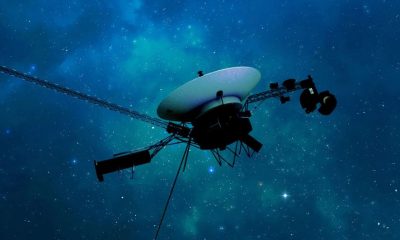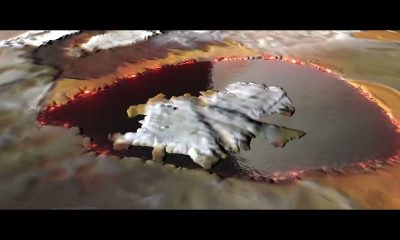News
Juno Observes Europa’s Oxygen Production

If the periodic table listed the elements in order of their importance to life, then oxygen might bully its way to the top. Without oxygen, Earth’s complex life likely would not exist. So when scientists detect oxygen on another world, they turn their attention to it.
During Juno’s ambitious mission to the Jovian system, it performed some flybys and observations of some of the Jovian moons. One of those moons, Europa, is a prime target in the search for life because of its subsurface ocean. It became an even more important target when scientists realized that the icy moon was producing oxygen.
We can’t see it with our organic eyes, but Europa’s surface is under bombardment. Not by rocky objects, which do strike occasionally, but by energetic particles. Europa is in a perilous position so close to giant Jupiter, and the planet makes its presence known.
Jupiter’s enormously powerful magnetic field sends a constant stream of charged particles at Europa. The much smaller moon has no defence. When those particles strike Europa’s icy surface, they split water molecules apart and produce hydrogen and oxygen.
“Europa is like an ice ball slowly losing its water in a flowing stream. Except, in this case, the stream is a fluid of ionized particles swept around Jupiter by its extraordinary magnetic field,” said JADE scientist Jamey Szalay from Princeton University in New Jersey. “When these ionized particles impact Europa, they break up the water-ice molecule by molecule on the surface to produce hydrogen and oxygen. In a way, the entire ice shell is being continuously eroded by waves of charged particles washing up upon it.”
Szalay is the lead author of new research published in Nature Astronomy. The research is “Oxygen production from dissociation of Europa’s water-ice surface.”
One of Juno’s instruments is JADE, the Jovian Auroral Distributions Experiment. JADE can detect and measure ions and electrons, primarily in Jupiter’s aurora and magnetosphere regions. In September of 2022, Juno came to within 354 km (220 miles) of Europa. During that flyby, JADE measured the hydrogen and oxygen ions created by the particles bombarding the moon.
Scientists have known about the bombardment and the hydrogen and oxygen since the days of the Galileo mission. But Juno’s updated instruments are providing new insights into the phenomenon.
“Back when NASA’s Galileo mission flew by Europa, it opened our eyes to the complex and dynamic interaction Europa has with its environment. Juno brought a new capability to directly measure the composition of charged particles shed from Europa’s atmosphere, and we couldn’t wait to further peek behind the curtain of this exciting water world,” said Szalay. “But what we didn’t realize is that Juno’s observations would give us such a tight constraint on the amount of oxygen produced in Europa’s icy surface.”
Knowing oxygen is being produced and knowing how much are two different things. It’s possible that some of this oxygen is making its way back down through the ice into the warm, salty ocean that probably exists there. If enough oxygen makes its way into the water, it’s one more factor in favor of life.

This new research is refining scientists’ understanding of how much oxygen is being produced on Europa. While previous research into Europa’s oxygen was based on models, these results are based on Juno’s measurements.
“Europa’s atmospheric composition had never been directly sampled, and model-derived oxygen production estimates ranged over several orders of magnitude,” the authors write in their research. “Here, we report direct observations of H2+ and O2+ pickup ions from the dissociation of Europa’s water-ice surface and confirm these species are primary atmospheric constituents.”
Previous research arrived at disparate estimates of the icy moon’s oxygen production. Some said only a few kilograms of oxygen are produced per second, while others range as high as 1000 kilograms per second. But thanks to Juno’s direct sampling, this research puts the amount of oxygen produced on Europa at 12 kg (26 lbs) per second.
Quantifying the amount of oxygen produced is a critical part of understanding the moon and its environment. It’s also a critical part of understanding the moon’s potential habitability. But for the oxygen to do any life-enabling work, it has to find its way through the ice into the ocean. Does it?

When the particles dissociate the water molecules into hydrogen and oxygen, the hydrogen is so light that it escapes Europa’s gravity. But the oxygen is heavier. It sticks around and forms part of Europa’s thin, tenuous atmosphere, making it one of only a handful of Solar System moons to have an atmosphere and one of an even smaller number of worlds with oxygen.
Multiple studies show that the released oxygen doesn’t all remain in the atmosphere. Research published in 2022 shows that oxygen can make it through the ice and down into the ocean. It’s all because of the moon’s ‘chaos terrain.’

Europa’s chaos terrain covers about one-quarter of the moon’s surface. Its exact cause is uncertain but is likely related to heating and melting taking place underneath it. The chaos terrain might sit over the top of lakes of melted brine contained in the moon’s icy shell. These lakes aren’t directly connected to the ocean but can drain into them.
Some of these lakes may be only 3 km (1.9 miles) below the surface, according to the 2022 research. The authors say that the surface oxygen can mix with the water in these lakes, which then drains into the ocean. If that’s the case, then the ocean may contain enough oxygen to support microbial life.

“Our research puts this process into the realm of the possible,” said the lead author of the 2022 research. “It provides a solution to what is considered one of the outstanding problems of the habitability of the Europa subsurface ocean.”
We don’t know if this process takes place on Europa yet. But the oxygen has to go somewhere, so the whole idea is very intriguing.
These new findings are all a result of Juno’s extended mission. The extended mission sent Juno through Europa’s torus, the ring-shaped cloud of ions around the moon so that JADE could take these important measurements.

“Our ability to fly close to the Galilean satellites during our extended mission allowed us to start tackling a breadth of science, including some unique opportunities to contribute to the investigation of Europa’s habitability,” said Scott Bolton, Juno’s principal investigator from the Southwest Research Institute in San Antonio. “And we’re not done yet. More moon flybys and the first exploration of Jupiter’s close ring and polar atmosphere are yet to come.”
Juno will keep gathering data until its extended mission ends in 2025 or until the spacecraft stops functioning. The extreme radiation at Jupiter is slowly eroding the spacecraft’s electronics, though they’re inside a protective titanium vault.
The Europa Clipper will be the next mission to the Jovian system. It’s focused on Europa and should tell us more about the moon’s oxygen and potential habitability when it reaches the system in 2030.
News
University of Wisconsin-Milwaukee and Protesters reach an agreement to dismantle encampment

Protesters at the University of Wisconsin-Milwaukee have agreed to end their pro-Palestinian encampment following an agreement reached with the school, university officials announced on Sunday. The encampment, which had been in place for two weeks, will be dismantled by Tuesday, marking the end of what was believed to be the last standing encampment at a Wisconsin college.
University officials had allowed the encampment to remain on a patch of lawn between Mitchell Hall and a busy thoroughfare on the campus’s southern boundary, opting not to involve law enforcement. This approach differed from the response at the University of Wisconsin-Madison, where police were called in to remove tents after negotiations fell through. Despite initial efforts to disband the encampment, Wisconsin-Madison eventually reached an agreement with protesters to voluntarily dismantle the camp prior to commencement ceremonies.
Chancellor Mark Mone of Wisconsin-Milwaukee stated last Wednesday that the university had exhibited “the widest possible amount of patience and restraint.” However, he also cautioned that patience was wearing thin and hinted at potential action by the school. Following discussions with the UWM Popular University for Palestine Coalition, the university agreed to advocate for a cease-fire between Israel and Hamas, condemn the destruction of schools and universities in Gaza by Israeli forces, and hold meetings with protest leaders regarding university investments.
Additionally, the university pledged to urge the Water Council, a Milwaukee organization of water technology companies, to sever connections with two Israeli government-owned entities, Mekorot and the Israel Innovation Authority. Chancellor Mone serves as the treasurer on the Water Council’s board of directors.
In return for these commitments, the protesters agreed to dismantle the encampment beginning on Sunday and completing the process by Tuesday. They also agreed not to disrupt the university’s commencement ceremonies scheduled for Sunday. In a statement, the protesters expressed their satisfaction with the agreement, stating, “After hard fought edits and careful consideration by the coalition, we determined we had obtained all possible benefits from the encampment.”
The resolution of the encampment at the University of Wisconsin-Milwaukee represents a successful outcome of negotiations between university officials and protesters. By reaching a compromise that addresses the concerns of both parties, a peaceful resolution has been achieved, allowing for the encampment to be taken down without incident.























